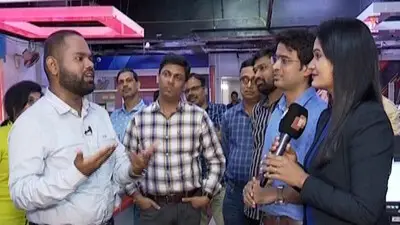Recommended Stories
Act first, think later. That appears to be the golden principle the Shree Jagannath Temple Administration (SJTA) has been following religiously. Any hope that the change of guard at the top would put the messy affairs of the 12th century shrine back in order was rudely shattered on Wednesday when hundreds of angry residents of the pilgrim town ransacked the barricades on the way to the temple and vandalized the SJTA office. They were protesting against the introduction of the ‘dhadi darshan’ (queue system) for devotees on an experimental basis since Monday.
That the temple administration did not see it coming speaks volumes about the consultative process after which the decision was supposedly implemented. In hindsight, it now becomes clear that the SJTA was lying when it said after the last meeting of the temple management committee that agreement had been reached on all but three of the 12 reform measures proposed by the Puri district judge in his report to the Supreme Court because ‘queue system’ was not among the three on which differences apparently persisted.
The protestors got what they wanted. In the wake of the violence on Wednesday, the administration promptly exempted residents of Puri from the queue system and allowed them to enter through the three gates other than the Lion’s Gate as long as they produce an identity card proving their residential status. This was only the latest in a series of flip flops that have marked decision making by the SJTA since the mega Brahma Parivartan fiasco during the Nabakalebara in 2015. Like all its decisions since then, it was taken without adequate thought to its repercussions. Barely hours after the announcement of the decision, it became clear that it would lead to more problems than it solves. People from the rest of Odisha – and indeed the world – have made their displeasure known in no uncertain terms at this blatantly partisan decision that drives a wedge between devotees of Puri and the rest of the world. In trying to calm the ruffled feathers of a few thousand residents of Puri, the administration has unwittingly ruffled the feathers of lakhs of devotees who live elsewhere. “Why should the people of Puri get preferential treatment? After all, He is the Lord of the Universe!” is the standard refrain of people living outside the pilgrim town.
There is certainly a case for exempting Puri residents from the queue because there are hundreds of people - young and old; men and women – who don’t touch food and even water before they have their customary darshan of the deities in the morning. To expect them to stand in a queue for hours is no doubt heartless. But is there really a case for introducing a queue system for darshan in the first place? Many people have serious reservations on this score. They point out, rightly so, that the traditions and rituals of the Jagannath Temple are unique and markedly different from those at other famous Hindu shrines in India like Tirupati or Shirdi. Lord Jagannath, after all, is the only God who, like humans, goes through all the daily chores from brushing his teeth to having his bath to having his siesta and finally going to bed. That’s why it is wrong to ape the system followed at other temples, they argue.
It is not as if ‘dhadi darshan’ is an alien concept in the Puri temple. Barricades are erected to regulate the crowd on special occasions like Kartik Purnima, Dasahara and New Year when the crowd is much bigger than on a normal day. And no one – neither residents of Puri nor their counterparts elsewhere – has had a problem with that. The problem arose because the administration decided to make it a daily affair.
There is, however, no dearth of people who believe the introduction of queue is a desirable step that would streamline entry into the temple. But there is a serious danger of the remedy becoming worse than the ailment. Imagine standing barefoot in a queue for hours in the scorching summer heat waiting for your turn to get in. Mishaps are bound to occur. One way to regulate and prevent overcrowding at the Lion’s Gate could be to allow a fixed number of devotees to enter at one go and letting the next batch in only after the first has dissolved into sprawling temple complex.
Those who know the unique traditions of the Jagannath temple consider the digging up of the Baisi Pahacha (22 steps) to erect iron bars blasphemous. Baisi Pahacha, as every visitor to the shrine knows, is integral to the traditions of the temple. On their way back from darshan of the deities, devotees offer Mahaprasad to their forefathers at Baisi Pahacha while toddlers are rolled over on the steps by their parents in the belief that it would give the child a long life. Many devotees first offer their prayers at the Bata Ganesha on the side of the Baisi Pahacha before entering the main shrine. With the steps barricaded, Bata Ganesha would now be out of bounds for them.
The incidents on Wednesday were a lesson in how not to manage the affairs of the temple. To begin with, the temple administration spoke in many voices with one official saying the queue system will be tried out once a week to see how it goes and another saying it would be in force for a month. Yet another official said there would be no dhadi darshan in the holy month of Kartik. What this flip flop proved was that the authorities had not done due diligence before announcing the decision. The decision to arrest Priyadarshan Patnaik, convenor of the Jagannath Sena, which had given the call for the bandh on Wednesday, as a ‘preventive measure’ had disaster written all over it. It led to eminently avoidable violence and arson. The officials completed their (mis)management by remaining conspicuously absent at a time when Puri was burning and the situation required them to take charge. Coming as it did 24 hours too late, the threat of action based on video footage by the DGP and the SJTA chief administrator scared no one.
This author was appalled to find the chief administrator perpetuate the myth that the SJTA is only implementing the Supreme Court ‘direction’ even at this late stage when the truth is the apex court has not issued any such instructions. All it has done is to ask the temple administration to explore the possibility of implementing the 12 reforms measures proposed by the district judge after extensive discussion with ‘all stakeholders’. Gopal Subramaniam, the amicus curie appointed by the court, had visited Puri and talked to all stakeholders last month as part of the process of consensus building. Where on earth did the question of a Supreme Court ‘directive’ come from? If there indeed was such a ‘directive’ then why did the chief administrator say that agreement was yet to be reached on three counts? Many people suspect the claim about the ‘directive’ is an attempt to hoodwink the people.
Senior Puri based journalist Srikumar Sukla makes a valid point when he says the decision to appoint a senior IAS officer as the administrator has created more problems than it has solved. “The affairs of the temple ran smoothly when a lone OAS managed all the affairs of the temple. The problem started only after the government decided to appoint a commissioner rank officer, who has no knowledge of the ground realities, as administrator,” he says.
As this columnist sees it, the problem is not so much with the appointment of IAS officer as administrator, but the ‘part time’ nature of their job. Every administrator in the recent past has been saddled with two - sometimes three - full time responsibilities, besides being entrusted with the task of looking after the affairs of the shrine. No wonder the temple takes a back seat. And there lies the problem because managing the affairs of the temple is a full time, 24X7 job.
By all means appoint a senior IAS office as temple administrator, but don’t assign him any other responsibility. And more importantly, provide him quarters in Puri and ask him to stay there and not in Bhubaneswar. That may end the ad-hocism that has marked decision making by the temple administration all these years.
(DISCLAIMER: This is an opinion piece. The views expressed are author’s own and have nothing to do with OTV’s charter or views. OTV does not assume any responsibility or liability for the same)













